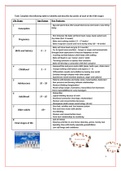Task: Complete the following table to identify and describe key points of each of the 8 life stages
Life Stage Age Range Key Features
1 . Egg and sperm fuse after sexual intercourse and create a new living
Conception being
2 . First trimester the baby will form heart, lungs, head, spinal cord,
Pregnancy tiny limbs (first 13 weeks)
. Baby start sucking motion (13 – 27 weeks)
. Baby recognizes sounds and move during sleep (28 – 40 weeks)
3 . Baby will close hand and grip (0-2 months)
Birth and Infancy 0–3 . Cry to signal some emotions – hunger or anger and communicate
through facial expressions if they feel happiness or fear
. Crawling and find balance which helps with walking
. Baby will begin to say ‘mama’ and/or ‘dada’
. Throwing tantrums to express their emotions.
. Baby will develop a connection with their caregiver
4 . Improved fine and gross motor skills (jump, hold a pen, climb stairs)
Childhood 3–9 . Change clothing with buttons and zippers (3 – 5)
. Differentiate sounds and syllables by leaning new words
. Socialize through roleplay with other people
. Experiences mixed emotions (jealousy, anger and sadness)
5 . Puberty with females and males (acne, menstruation, body hair)
Adolescence 10 – 18 . Peer pressure and forming intimate relationships
. Abstract thinking (imagination)
. Mood swings (anger, frustration, insecurities) from hormones
.More responsibilities for some teenagers
6 . Maturation
Adulthood 19 – 65 . Logical thinking because of work
. Emotional connection (marriage, relationships)
. Memory and concentration decreases
. Menopause which causes mood swings (45-65)
7 . Grey hair, wrinkles and low immune system
Older adults 65+ . Fine and Gross motor skills decline
. Overthinking
. Memory and concentration issues
. Form new relationships by socializing
8 . Lack of energy
Final stages of life . Enjoying activities in care homes (dancing, games, having tea)
. Spending time with family especially grandchildren
. Low self-image and confidence
1
, Task: Complete a detailed definition for each of the key terms below.
1. Growth
This is an increase in size, weight or height.
2. Development
Development means learning more skills, emotions and abilities throughout a person’s
lifespan.
3. Developmental norms
The normal development expected to happen in an individual life such as the a child
learning how to walk or say the first words.
4. Developmental milestones
The points at which certain things are expected to happen, for example walking or
starting puberty.
5. Life course
Events happening through the life span such as going to school, working, marriage,
building a family and retiring.
6. Maturation
Is the development of growing up for example starting adulthood and having many
responsibilities such as a career and bills to pay.
7. Life expectancy
This is the calculation of how long an individual will be expected to live. There is usually an
approximate average age.
2




